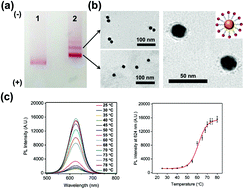DNA-templated nanoparticle complexes for photothermal imaging and labeling of cancer cells†
Abstract
In situ monitoring of the photothermal (PT) effect at the cellular level is of great importance in the photothermal (PT) treatment of cancer. Herein, we report a class of DNA-templated gold nanoparticle (GNP)–quantum dot (QD) complexes (GQC) for PT sensing in solution and in cancer cells in vitro. Specifically, the QD photoluminescence (PL) could be activated at elevated temperature with a wide thermo-responsive range between 45 °C and 70 °C, which fits the temperature threshold for effective cancer cell ablation. The general applicability of GQC for intracellular PT sensing is explored using three types of PT agents (gold nanorods (GNRs), gold nanostars (GNSs), and Prussian blue nanoparticles (PBNPs)) with various PT performances. We show that the intracellular QD PL is gradually activated with increasing near-infrared (NIR) irradiation time, providing a good correlation with the surrounding medium temperature for PT sensing. Moreover, we demonstrate that the GQC sensor could be used for specific photothermal labeling and imaging of cancer cells. The QD PL signal is retained in the cells post-treatment, thereby potentially enabling persistent photothermal labeling of cancer cells for post-treatment cell tracking and imaging-guided therapy evaluation.



 Please wait while we load your content...
Please wait while we load your content...